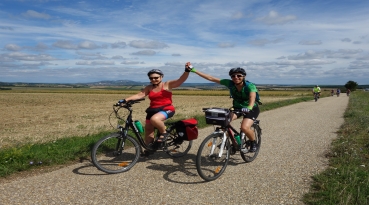Cycling Safety
(Instructions for participants of AVE Travel bicycle tours)
Every participant of a bicycle tour has to consider his own responsibility for HIS/HER safety.
Every participant has to obey the following basic rules to prevent injury:
- Follow all instructions of the tour guide.
- Wear a bicycle helmet (compulsory on AVE tours).
- Wear safe and suitable clothes (bright colors, beware of getting trouser-leg caught in the chain ring).
- Bicycle gloves are recommended.
- Do not tie any clothing to the bike.
- Ride on the right side.
- A group rides in single file on roads.
- Keep a safe distance from other bikers (at least 5m when riding slowly).
- Give priority to pedestrians.
- Take care around children.
- Use bike-bell while passing pedestrians.
- Be Predictable - Group riding requires even more attention to predictability than riding alone. - - - Other riders expect you to ride straight, at a constant speed, unless you indicate differently.
- Give notice while changing direction or stopping.
- Hand Signals - Hand signals for turning and stopping are as follows: Left are straight out to - signal a left turn. Left arm out and down with you palm to the rear to signal slowing or stopping. And, for a right turn, put your right arm straight out (in areas where this is legal) or put your left arm out and bent up.
- Announce Hazards - When riding in a tight group, most of the cyclists do not have a good view of the road surface ahead, so it is important to announce holes, gravel, grates, and other hazards. Indicate road hazards by pointing down to the left or right, and by shouting "hole," "bump," etc., where required for safety. Everyone in a group should be made aware of hazards. However, not everyone needs to announce them
- Move Off the Road When You Stop - Whether you are stopping because of mechanical problems or to regroup with you companions, move well off the road so you don't interfere with traffic. It is usually best for the lead rider to pull forward in the stopping area and for other riders to pull in behind the rider in front of them. When you start up again, each cyclist should look for, and yield to, traffic.
- Leave a Gap for Cars - When riding up hills or on narrow roads where you are impeding faster traffic, leave a gap for cars between every three or four bicycles. This way motorists can take advantage of shorter passing intervals and eventually move piecemeal around the entire group.
- Wait at Turns - If the group becomes at all separated, even by a few dozen meters, someone should wait at the turn until the next rider arrives at the intersection, and so on until all riders have made the turn.
- Don't separate from the group.
- Don't pass other cyclists on the right.
- Adjust your speed to the route conditions and to your capability.
- Slow down on wet or slippery route surface.
- Go slowly and steadily downhill - beware of speeding out of control.
- Cross tram or train rails perpendicularly.
- Pedestrian crossing - a biker cycling on a pedestrian crossing DOES NOT have priority. That's why when crossing the street on a pedestrian crossing, we walk with the bikes.
- Don't ride on sidewalks unless no other safe option exists. Motorists at intersections or when leaving or entering driveways often do not see swift-moving cyclists traveling on sidewalks.
- Pedestrian zone - if not allowed by a road sign, bikers walk with bikes.
- Make sure that your hands can reach and squeeze the brake levers comfortably.
- Brake while riding straight ahead only.
- Do not brake while riding on slippery surface or on a bend
- For most effective braking, use both brakes and apply them simultaneously.
- Consider the rider behind you while braking.
- Do everything with your left hand while riding the bike (drinking, adjusting of the helmet or glasses etc.). Right hand has to be ready to brake in case of need!
- Beware of looking back! The handlebar turns the same way as your neck.
- Push the bicycle on dangerous parts of the route or at road crossings.
- Concentrate on the bike ride only.
- Do not ride drunk.
- What to do if you get lost from the group? Go to the place where you were with the group last time and wait there.
Recommended technique for safe braking:
Squeeze the lever progressively increasing the braking force. If you feel the wheel begin to lock-up, release pressure just a little bit to keep the wheel rotating.
WARNING !
Sudden or excessive application of the front brake may pitch the rider ahead over the handlebars, causing serious injury.
The brakes are powerful. Applying brakes too hard or too suddenly can lock up a wheel, which could cause you to lose control and fall.
Recommended multi-day tours





 MENU
MENU


